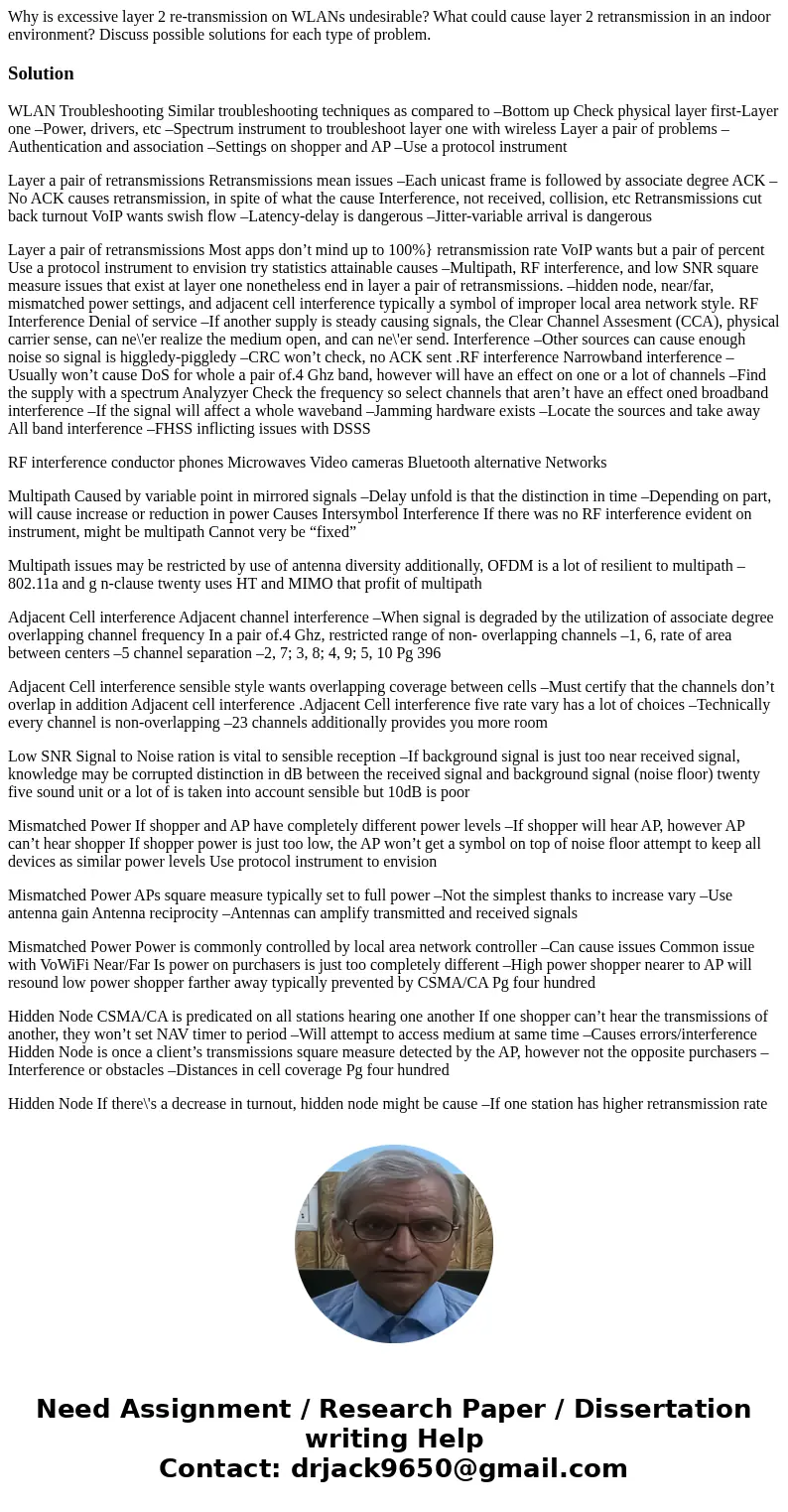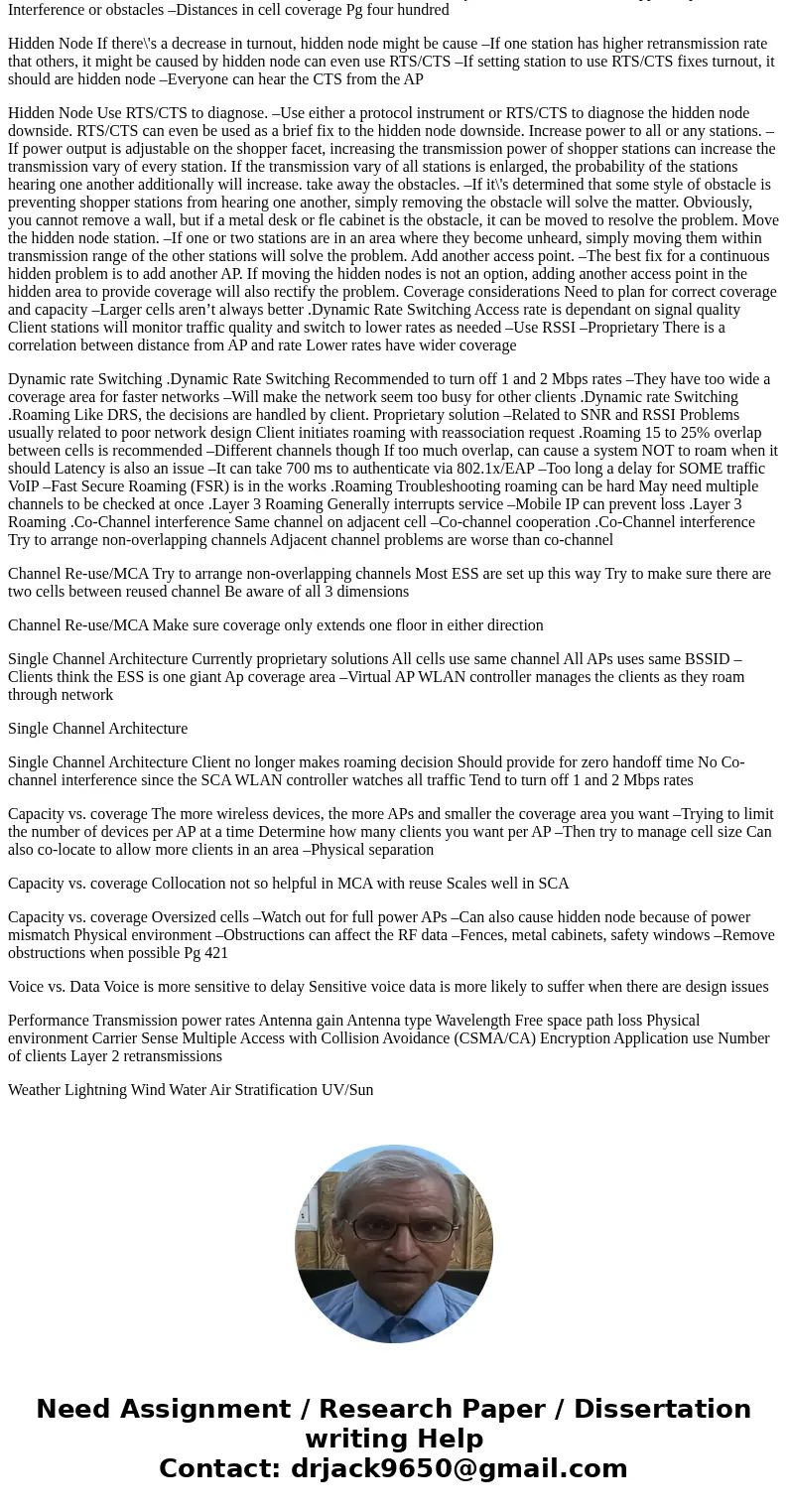Why is excessive layer 2 retransmission on WLANs undesirable
Why is excessive layer 2 re-transmission on WLANs undesirable? What could cause layer 2 retransmission in an indoor environment? Discuss possible solutions for each type of problem.
Solution
WLAN Troubleshooting Similar troubleshooting techniques as compared to –Bottom up Check physical layer first-Layer one –Power, drivers, etc –Spectrum instrument to troubleshoot layer one with wireless Layer a pair of problems –Authentication and association –Settings on shopper and AP –Use a protocol instrument
Layer a pair of retransmissions Retransmissions mean issues –Each unicast frame is followed by associate degree ACK –No ACK causes retransmission, in spite of what the cause Interference, not received, collision, etc Retransmissions cut back turnout VoIP wants swish flow –Latency-delay is dangerous –Jitter-variable arrival is dangerous
Layer a pair of retransmissions Most apps don’t mind up to 100%} retransmission rate VoIP wants but a pair of percent Use a protocol instrument to envision try statistics attainable causes –Multipath, RF interference, and low SNR square measure issues that exist at layer one nonetheless end in layer a pair of retransmissions. –hidden node, near/far, mismatched power settings, and adjacent cell interference typically a symbol of improper local area network style. RF Interference Denial of service –If another supply is steady causing signals, the Clear Channel Assesment (CCA), physical carrier sense, can ne\'er realize the medium open, and can ne\'er send. Interference –Other sources can cause enough noise so signal is higgledy-piggledy –CRC won’t check, no ACK sent .RF interference Narrowband interference –Usually won’t cause DoS for whole a pair of.4 Ghz band, however will have an effect on one or a lot of channels –Find the supply with a spectrum Analyzyer Check the frequency so select channels that aren’t have an effect oned broadband interference –If the signal will affect a whole waveband –Jamming hardware exists –Locate the sources and take away All band interference –FHSS inflicting issues with DSSS
RF interference conductor phones Microwaves Video cameras Bluetooth alternative Networks
Multipath Caused by variable point in mirrored signals –Delay unfold is that the distinction in time –Depending on part, will cause increase or reduction in power Causes Intersymbol Interference If there was no RF interference evident on instrument, might be multipath Cannot very be “fixed”
Multipath issues may be restricted by use of antenna diversity additionally, OFDM is a lot of resilient to multipath –802.11a and g n-clause twenty uses HT and MIMO that profit of multipath
Adjacent Cell interference Adjacent channel interference –When signal is degraded by the utilization of associate degree overlapping channel frequency In a pair of.4 Ghz, restricted range of non- overlapping channels –1, 6, rate of area between centers –5 channel separation –2, 7; 3, 8; 4, 9; 5, 10 Pg 396
Adjacent Cell interference sensible style wants overlapping coverage between cells –Must certify that the channels don’t overlap in addition Adjacent cell interference .Adjacent Cell interference five rate vary has a lot of choices –Technically every channel is non-overlapping –23 channels additionally provides you more room
Low SNR Signal to Noise ration is vital to sensible reception –If background signal is just too near received signal, knowledge may be corrupted distinction in dB between the received signal and background signal (noise floor) twenty five sound unit or a lot of is taken into account sensible but 10dB is poor
Mismatched Power If shopper and AP have completely different power levels –If shopper will hear AP, however AP can’t hear shopper If shopper power is just too low, the AP won’t get a symbol on top of noise floor attempt to keep all devices as similar power levels Use protocol instrument to envision
Mismatched Power APs square measure typically set to full power –Not the simplest thanks to increase vary –Use antenna gain Antenna reciprocity –Antennas can amplify transmitted and received signals
Mismatched Power Power is commonly controlled by local area network controller –Can cause issues Common issue with VoWiFi Near/Far Is power on purchasers is just too completely different –High power shopper nearer to AP will resound low power shopper farther away typically prevented by CSMA/CA Pg four hundred
Hidden Node CSMA/CA is predicated on all stations hearing one another If one shopper can’t hear the transmissions of another, they won’t set NAV timer to period –Will attempt to access medium at same time –Causes errors/interference Hidden Node is once a client’s transmissions square measure detected by the AP, however not the opposite purchasers –Interference or obstacles –Distances in cell coverage Pg four hundred
Hidden Node If there\'s a decrease in turnout, hidden node might be cause –If one station has higher retransmission rate that others, it might be caused by hidden node can even use RTS/CTS –If setting station to use RTS/CTS fixes turnout, it should are hidden node –Everyone can hear the CTS from the AP
Hidden Node Use RTS/CTS to diagnose. –Use either a protocol instrument or RTS/CTS to diagnose the hidden node downside. RTS/CTS can even be used as a brief fix to the hidden node downside. Increase power to all or any stations. –If power output is adjustable on the shopper facet, increasing the transmission power of shopper stations can increase the transmission vary of every station. If the transmission vary of all stations is enlarged, the probability of the stations hearing one another additionally will increase. take away the obstacles. –If it\'s determined that some style of obstacle is preventing shopper stations from hearing one another, simply removing the obstacle will solve the matter. Obviously, you cannot remove a wall, but if a metal desk or fle cabinet is the obstacle, it can be moved to resolve the problem. Move the hidden node station. –If one or two stations are in an area where they become unheard, simply moving them within transmission range of the other stations will solve the problem. Add another access point. –The best fix for a continuous hidden problem is to add another AP. If moving the hidden nodes is not an option, adding another access point in the hidden area to provide coverage will also rectify the problem. Coverage considerations Need to plan for correct coverage and capacity –Larger cells aren’t always better .Dynamic Rate Switching Access rate is dependant on signal quality Client stations will monitor traffic quality and switch to lower rates as needed –Use RSSI –Proprietary There is a correlation between distance from AP and rate Lower rates have wider coverage
Dynamic rate Switching .Dynamic Rate Switching Recommended to turn off 1 and 2 Mbps rates –They have too wide a coverage area for faster networks –Will make the network seem too busy for other clients .Dynamic rate Switching .Roaming Like DRS, the decisions are handled by client. Proprietary solution –Related to SNR and RSSI Problems usually related to poor network design Client initiates roaming with reassociation request .Roaming 15 to 25% overlap between cells is recommended –Different channels though If too much overlap, can cause a system NOT to roam when it should Latency is also an issue –It can take 700 ms to authenticate via 802.1x/EAP –Too long a delay for SOME traffic VoIP –Fast Secure Roaming (FSR) is in the works .Roaming Troubleshooting roaming can be hard May need multiple channels to be checked at once .Layer 3 Roaming Generally interrupts service –Mobile IP can prevent loss .Layer 3 Roaming .Co-Channel interference Same channel on adjacent cell –Co-channel cooperation .Co-Channel interference Try to arrange non-overlapping channels Adjacent channel problems are worse than co-channel
Channel Re-use/MCA Try to arrange non-overlapping channels Most ESS are set up this way Try to make sure there are two cells between reused channel Be aware of all 3 dimensions
Channel Re-use/MCA Make sure coverage only extends one floor in either direction
Single Channel Architecture Currently proprietary solutions All cells use same channel All APs uses same BSSID –Clients think the ESS is one giant Ap coverage area –Virtual AP WLAN controller manages the clients as they roam through network
Single Channel Architecture
Single Channel Architecture Client no longer makes roaming decision Should provide for zero handoff time No Co-channel interference since the SCA WLAN controller watches all traffic Tend to turn off 1 and 2 Mbps rates
Capacity vs. coverage The more wireless devices, the more APs and smaller the coverage area you want –Trying to limit the number of devices per AP at a time Determine how many clients you want per AP –Then try to manage cell size Can also co-locate to allow more clients in an area –Physical separation
Capacity vs. coverage Collocation not so helpful in MCA with reuse Scales well in SCA
Capacity vs. coverage Oversized cells –Watch out for full power APs –Can also cause hidden node because of power mismatch Physical environment –Obstructions can affect the RF data –Fences, metal cabinets, safety windows –Remove obstructions when possible Pg 421
Voice vs. Data Voice is more sensitive to delay Sensitive voice data is more likely to suffer when there are design issues
Performance Transmission power rates Antenna gain Antenna type Wavelength Free space path loss Physical environment Carrier Sense Multiple Access with Collision Avoidance (CSMA/CA) Encryption Application use Number of clients Layer 2 retransmissions
Weather Lightning Wind Water Air Stratification UV/Sun


 Homework Sourse
Homework Sourse